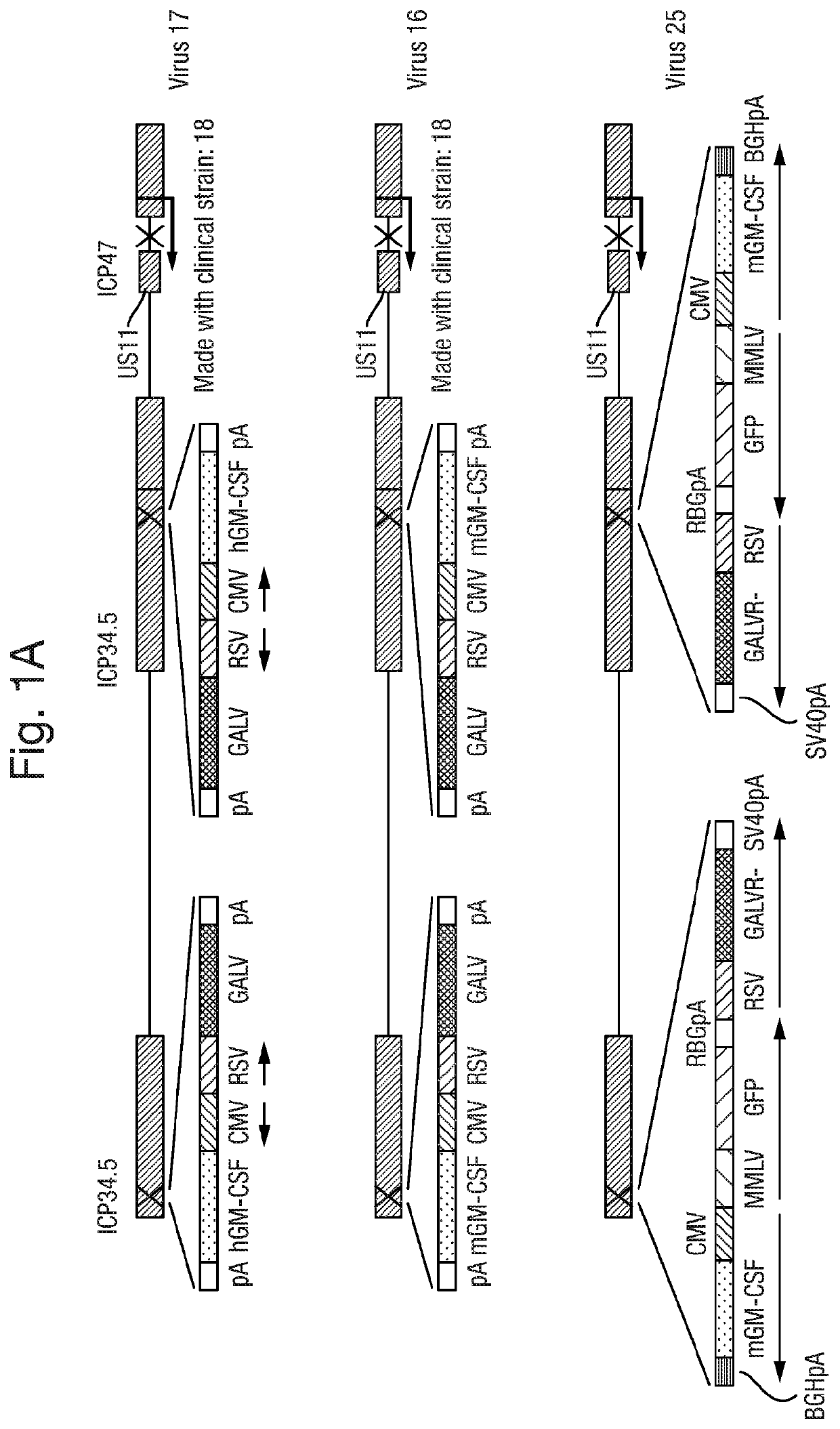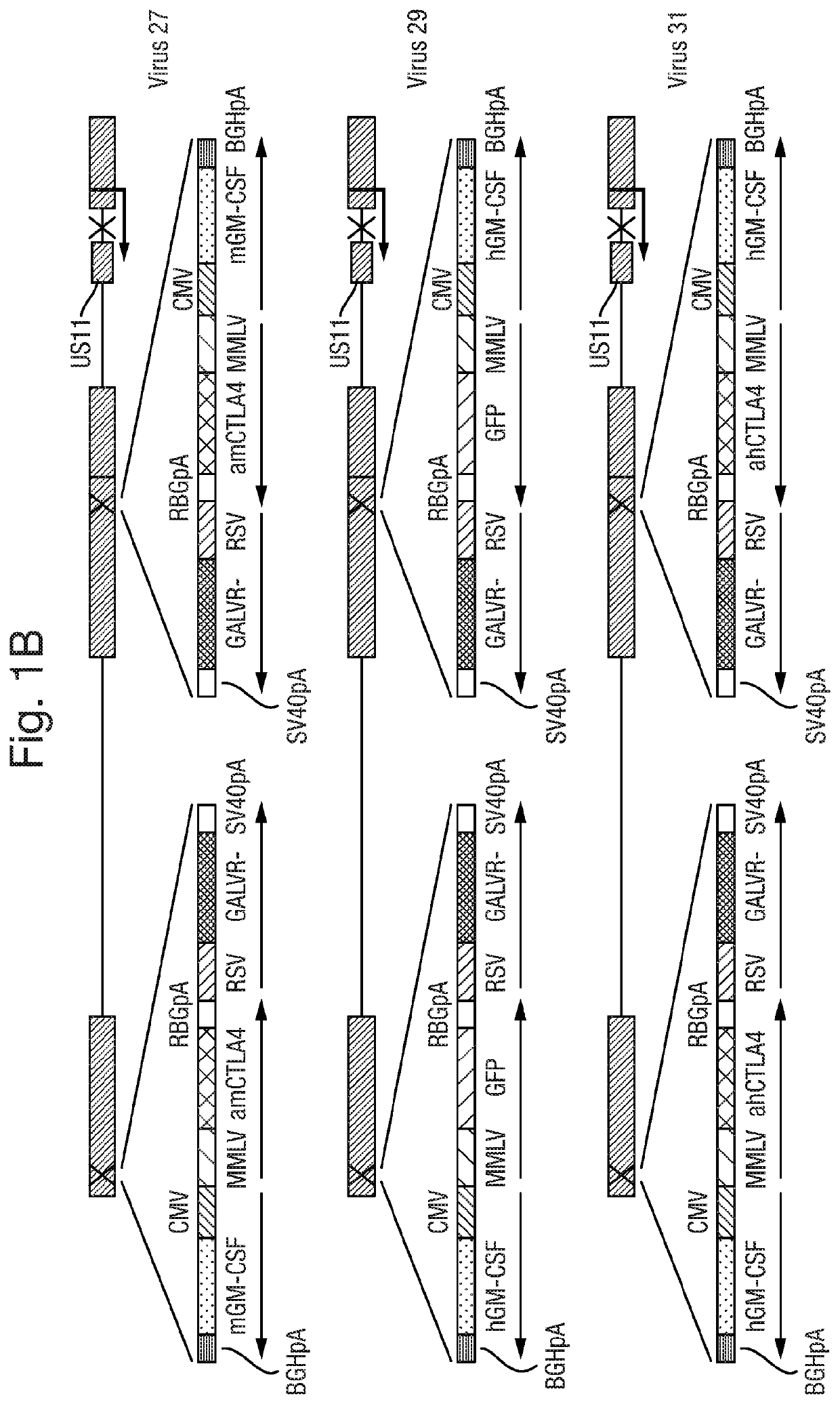Altered virus
- Summary
- Abstract
- Description
- Claims
- Application Information
AI Technical Summary
Benefits of technology
Problems solved by technology
Method used
Image
Examples
example 1
ion of a Virus of the Invention
[0176]The virus species used to exemplify the invention is HSV, specifically HSV1,
[0177]Diagrams of the plasmids used are shown in FIG. 2, Diagrams of the viruses are shown in FIG. 1. All viruses were constructed using HSV1 Strain RH018A, The plasmids used for virus construction were generated by a combination of gene synthesis and subcloning, conducted by Genscript Inc.
[0178]Viruses expressing anti-mouse CTLA4 together with mouse GM-CSF and GAIN were constructed by co-transfection of Plasmid 77 with Virus 16 DNA, so as to insert GFP into Virus 16 by selection of plaques expressing MT to give Virus 25. GFP was then knocked out of Virus 25 by co-transfection of Virus 25 DNA with Plasmid 119. This gave Virus 27.
[0179]Viruses expressing anti-human CTLA4 together with human GM-CSF and GALV were constructed by co-transfection of Plasmid 78 with Virus 17 DNA, so as to insert GFP into Virus 17 by selection of plaques expressing GFP to give Virus 29. GFP was t...
example 2
t of Combined Expression of GALV, GM-CSF and Anti-CTLA4 from an Oncolytic Virus
[0183]The utility of the invention is demonstrated in the following way, A20 cells are administered into both flanks of Balb / c mice and the A20 tumors are allowed to grow to approximately 0.5 cm in diameter.
[0184]The following treatments are then administered to groups of mice, into one flank of each mouse only (right tumor) 3 times per week for one week:[0185]50 μl of vehicle (1 group);[0186]50 μl of 106 pfu / ml of the HSV with only mouse GM-CSF and GALVR- inserted (Virus 16);[0187]50 μl of 106 pfu / ml of the HSV with GALV / R-, mouse GM-CSF and the anti-mouse CTLA-4 antibody inserted (Virus 27);
[0188]Effects on tumor growth arc then observed for up to one month. The dose of virus used was 5×104pfu (50 ul of 1×106 pfu / ml in each case), given three times over one week. This dose level of virus is subtherapeutic for uninjected tumors for virus 16, which allows the benefits of the delivery of the additional mol...
example 3
t of Combined Expression of GALV, GM-CSF and Anti-CTLA4 from an Oncolytic Virus with Anti-PD-1
[0189]A20 cells are administered into both flanks of Balb / c mice and the A20 tumors are allowed to grow to approximately 0.5 cm in diameter.
[0190]The following treatments are then administered to groups of mice (10 per group), into one flank of each mouse only 3 times per week for one week:[0191]50 μl of vehicle;[0192]Intraperitoneal anti-mouse PD1 (Bioxcell RMP-1-14 10 mg / kg every three days);[0193]50 μl of 107 pfu / ml of the HSV with GALVR-, mouse GM-CSF and the anti-mouse CTLA-4 antibody inserted (Virus 27)[0194]50 μof 107 pfu / ml, of the HSV with GALVR-, mouse GM-CSF and the anti-mouse CTLA-4 antibody inserted (Virus 27) together with intraperitoneal anti-mouse PD1 (10 mg / kg every three days) (3 groups),
[0195]Effects on tumor growth are then observed for up to 80 days. Superior tumor control and shrinkage in both injected and un-injected tumors when treatment with the virus is combined tr...
PUM
| Property | Measurement | Unit |
|---|---|---|
| Level | aaaaa | aaaaa |
Abstract
Description
Claims
Application Information
 Login to View More
Login to View More - R&D
- Intellectual Property
- Life Sciences
- Materials
- Tech Scout
- Unparalleled Data Quality
- Higher Quality Content
- 60% Fewer Hallucinations
Browse by: Latest US Patents, China's latest patents, Technical Efficacy Thesaurus, Application Domain, Technology Topic, Popular Technical Reports.
© 2025 PatSnap. All rights reserved.Legal|Privacy policy|Modern Slavery Act Transparency Statement|Sitemap|About US| Contact US: help@patsnap.com



